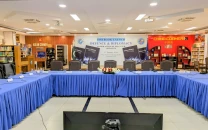Power hungry: Pennyfuellish
The less you burn the more you earn, that’s what the supporters of energy-efficient housing say.

The less you burn the more you earn, that’s what the supporters of energy-efficient housing say — and with a few small changes anyone in Pakistan can bring their electricity bill down.
Indeed, houses built in the city prior to the mid-1960s incorporated this weather element by including a veranda on the southwest side where a family could sit and enjoy their evening tea.
In the villages of Sindh, housing design developed over generations, without external influence. From the thickness of their walls to the orientation of their courtyards, a home’s every architectural detail responded to the environment. In Thatta, for example, houses had wind-catchers, a traditional Persian architectural element that creates natural ventilation.
“Local is not ghatiya, as the well-travelled and the so-called ‘educated’ people like to believe,” says Abdulla. “You belong to this region and your house should be indigenous to it.”
This is all very well and good for anyone planning to build a home. But what are people with houses to do now to save on their electricity bill, be energy efficient and in the process environmentally friendly? We spoke to a few experts on small changes, some expensive but worth it in the long run, and others relatively cheaper, that any homeowner can make starting today.
“Your first cost will always be high whenever you set out to do some optimisation around the house,” says Farhan Mehboob, a consulting engineer who has worked on major building projects in Pakistan and abroad, and who lectures internationally on energy efficiency. “But remember that your savings will also be significantly higher, especially in the long run.”
The roof over your head
Consider insulation to begin with. Farhan Mehboob stresses the need for proper insulation on roofs and in walls, and the right kind of glazing for windows. These are factors that will help determine the size of air conditioning units you will want to use to cool your home. A well-insulated home requires smaller air conditioners, and hence lesser energy.
One simple trick recommended by Hira Qadeer, an architect at the Design Office of the Aga Khan University Hospital, is covering your roof with old flower pots — something which will act as great insulation as their conical shape dissipates heat. Another option is to build a secondary structure over your roof, like one made out of an insulation material like fibreglass.
Shahid Abdulla says walls can be insulated by growing creepers along them. They are a neat way of keeping the building green while providing excellent insulation. “Grow deciduous trees, which are leafy in the summers and provide shade, but drop their leaves in the winters to allow more sunlight to reach your home,” he adds.
The added benefit of growing a lot of indigenous vegetation around your house, is that it invites birds, who add to the atmosphere.
Your neighbours
Many people forget that heat is lost and gained through walls as well and not just the roof. This is important if you’re living in an apartment building.
Temperature differences on both sides of the partition wall will have a direct affect on your electricity bill. “If it is 20 degrees in my room, and 27 degrees in my neighbour’s room, the laws of physics dictate that heat will flow into my room from my neighbour’s room — meaning my air conditioner will have to use more electricity to keep my room cool at 20 degrees,” Mehboob explains. Similarly, you should consider putting in false ceilings too.
Double glazing
Double-glazed windows minimise heat transfer as do tinted windows that restrict too much sunlight from penetrating and heating up your house in the summers. Overhangs for windows also keep them shaded from direct sunlight. But ask an architect or building engineer to work out an optimum angle for the overhang so that it cuts out direct sunlight during the summer months but lets it in during the winters, when the sun rides lower in the sky.
With new technology, you can consider using more glass on the south side of your house, with enough shade over it to cut out direct sun rays. In the winters, the sun moves south, and your house will automatically let in the sun, allowing it to warm up your house for free. The simple beauty of adopting this measure is that the sun moves north in the summers, and you can prevent heat gain if those windows are properly shaded.
Cooling down
According to Abdulla, as long as a house’s temperature ranges between 24 to 27 degrees, human beings feel comfortable. Or, if you can maintain a five-degree differential from the outside temperature, that too is enough.
Most experienced architects feel that there is no need to plug in large air conditioners around your house, especially in cities which enjoy cool evenings. Cross-ventilation helps ensure that wind keeps circulating through the house, keeping you comfortable through what is called the evaporative cooling effect.
When combined with walls that have cavities and appropriate cross-ventilation, AKU’s Qadeer estimates you can save up to 30% of your energy bill.
The thicker the wall, the more time it takes the outside heat to penetrate in during the summer, or out in the winter. This has a direct impact on how much air conditioning (and hence electricity) you will need to cool your house, or alternatively keep them warm.
“In the olden days,” recalls Abdulla, “homes were made for the summers, with thick walls that provided insulation. They were made of stone, so they did not allow builders to include large windows in the design: that property helped them minimise unwanted heat loss and gain.”
Abdulla and many other architects are proponents of greener architecture, which is mostly about not being wasteful. “You shut out natural light and put in light bulbs — that’s wasteful,” he points out. “The weather may be pleasant outside, but you have an air conditioner running away inside. That’s wasteful.”
Across Pakistan, our architectural history has actually been a very green one. Our forefathers used to sit on charpoys in the evening and enjoy the breeze. Our living rooms were airy, and families would minimise the use of electricity by sleeping together in one room, under one fan. Perhaps those days are gone now in certain cities, but as our electricity bill climbs perhaps we need to consider using technology that helps bringing it down while also being energy efficient.
Air Conditioning
Don’t go cheap. It costs in the long run. Consider getting what are called variant refrigerant flow units. They are the latest in air-conditioning technology as they intelligently modulate their use of electricity according to your needs. For example, they will run at, say, half capacity during evening or late night as temperatures are lower then and they will need less energy to cool the air. The newer technology acts like the regulators of ceiling fans, using only as much energy as is necessary to achieve the desired temperature.
“The peak consumption of these models is only 1.1 units, meaning a 60% saving on the bill even if they run at peak capacity most of the time,” explains Farhan Mehboob, a consulting engineer. “These units cost 2.5 to three times the average air conditioner, but think about their investment worth.” He recommends putting them in your bedrooms, which you use the most. Do not waste money putting them everywhere around the house.
“Avoid putting your external air conditioning units too close to each other,” Mehboob says. The hot air expelled from one unit in the process of air conditioning gets sucked into the other unit, meaning it has to work harder and thus use more energy to cool. “The unit that is receiving the hot air will consume 20% to 50% more energy. It is the worst and most wasteful thing you can possibly do,” he adds.
Walls

Building walls with internal cavities is a good idea, as they provide a layer of insulation which will keep heat out in the summer and in during the winter. You no longer need a two-foot wide wall to achieve that level of insulation — a 14-inch brick that is hollow on the inside will do the trick. Consider using red bricks if they are available in your region. They are the ideal ‘green’ building material, as they are made from clay and are completely recyclable. In Lahore they cost between Rs5,200 to Rs6,000 per 1,000 batch and this depends on the quality of brick and coal as some kilns bake them on tyres and some on coal. In Karachi, it costs Rs3,500 per 1,000 batch.
TVs — the red light
Check the energy efficiency ratings on the set before buying. You can buy a plasma TV for Rs60,000, which will consume 200 watts of electricity or you can buy an LED TV for Rs100,000, but it will use only 40 watts. This will reduce your electricity bill by 80%.
Appliances use energy even in standby mode. Switch them off when you’re not using them. Disconnect the power supply: even that tiny red light uses electricity and it all adds to costs in the long run.
LED bulbs — the future of lighting

The energy saver was the first revolution in lighting solutions after the halogen bulb. Similarly, the light-emitting diode or LED bulb is the harbinger of another revolution.
According to Faizan Malik, the proprietor of Litelogy — a branded outlet of Philips home lighting accessories — the company has introduced the warm white and white colours as direct replacements to the energy savers already in use in many households.
You may want to start off with lighting only the most frequently used places in your house with LEDs, to rationalise their cost with what they save you in terms of your energy bill.
“Prices of branded LEDs will fall, definitely, as they have over the past few years,” Malik says. “However, you must remember that a branded product charges you more because it delivers on what it promises you. A lot of money goes into perfecting the build, the quality and the life of such products, and companies will always recover R&D costs from consumers.”
Or you could take the Chinese option. “Chinese bulbs come dirt cheap as compared to the branded ones,” says Malik. “There is a Rs300 LED bulb in the market, for which a similar branded Philips replacement costs nearly Rs3,000. They are usually cheap rip-offs though, and tend to lose their light intensity and energy efficiency over time.”
Solar water heater & kits
They are a good choice to heat water during the colder months. Solar units are environmentally friendly and can now be installed on your roof. A lot of companies in Pakistan now offer solar kits for the home and the technology is steadily becoming cheaper. A 100-ltr heater starts at Rs28,000 and they go up to Rs43,000 for 200 litres. All of them can heat water to 80 degrees in six to eight hours.
Plumbing — plug it up

Consider installing taps that turn off automatically if they detect that nobody is using them. Auto Taps quoted us the starting price Rs22,500 for imported Grohe ones. The same goes for showers. Do away with bathtubs, as they are wasteful and increase your water usage unnecessarily.
Toilets — smart flushing
You can buy toilets with two flush volume button options for solid or liquid waste. This helps save on water and your bill as water is pumped into your tanks using electric motors. Their starting price is about Rs7,000.
If possible install a two-pipe sewerage system which differentiates between ‘black water’, used to flush human excreta and goes directly into the sewer and ‘gray water’ that can be saved. This is the used water from showering and cleaning and can be reused for the toilet flush or to water your plants after some minor chemical treatment.
Published in The Express Tribune, Sunday Magazine, April 14th, 2013.
Like Express Tribune Magazine on Facebook to stay informed and join the conversation.



















COMMENTS
Comments are moderated and generally will be posted if they are on-topic and not abusive.
For more information, please see our Comments FAQ